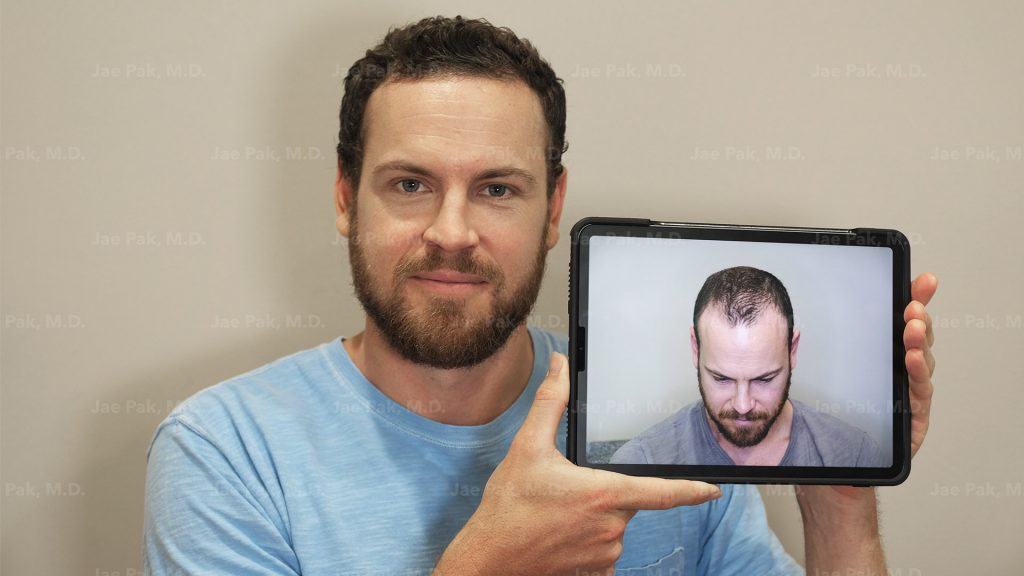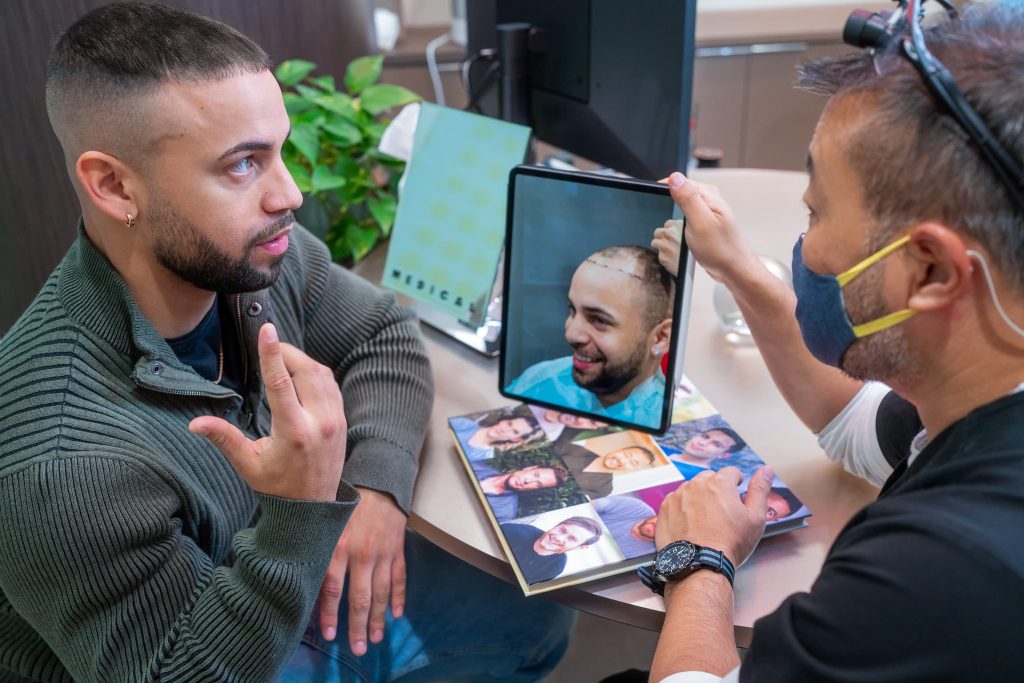
For years, hair loss professionals have marketed Follicular Unit Excision (FUE) as a faster, cleaner, and less invasive form of transplantation that yields great results.
Compared to traditional “strip surgery” methods, these claims are mostly true, especially regarding scar formation on the back of the scalp where the donor hair is harvested.
But even though FUE is the leading procedure in efficiency and risk reduction, the post-operative care journey is not necessarily easy. Some patients may be surprised to learn that results aren’t instantaneous and that some lifestyle adjustments are necessary for the first phases of recovery to maximize outcomes.
There’s no doubt that FUE works — and works well.
However, we want to achieve full transparency with clients no matter which procedure they pursue, which means being open and honest about expectations during recovery from FUE.
The exact goal of today’s article is to map out the FUE recovery timeline that the typical patient can expect, with all the details and descriptions that may be missing from most online summaries.
This is the no-nonsense, real-time guide you’ve been looking for that reveals the actual month-to-month experience after FUE surgery, including all the ups and downs along the way. If you’re serious about FUE and want all the relevant recovery info, you’re in the right place.
Before we dive into the timeline, let’s clarify that the lead-up to an FUE procedure also takes some time and effort.
This isn’t like getting a haircut or an impromptu dental cleaning – you’ll need to work closely with your surgeon during the consultation period to ensure success from the start. Here’s what takes place leading up to FUE and why it matters.

The primary aim of any consultation for cosmetic procedures is to set goals and align the patient’s expectations as they take the first steps towards those goals.
In the context of FUE surgery, this involves the patient describing their objectives for how they want to look, as well as their experience with hair loss and any medical or genetic factors that may help doctors plan accordingly.
While many patients seek out FUE specifically for its premium reputation, it’s possible that this isn’t the best procedure available for the individual. FUT surgery, for example, yields higher volumes of donor hair and may be preferred for the situation.
The point is that expectations and goals must be balanced during the consultation session, and the world’s best hair loss surgeons are able to guide clients through this process in a logical, reasonable way. Here at Jae Pak MD Medical, our staff is committed to the patient experience so you have realistic expectations.
After the scope and the aesthetic goals of surgery are in place, surgeons and clients may want to hammer out the details of the procedure that could better set the timeline for FUE at large.
These include everything from the exact number of grafts required for the surgery to the time and date of the procedure itself and any medications and therapies recommended to supplement recovery and hair growth post-op.
The objective here is to clarify all aspects of the surgery, from time and place to payment, follow-up meetings, and more. Top surgeons pride themselves on transparency and often anticipate the needs of clients by preemptively answering the most important questions.
From the patient’s perspective, getting ready for FUE surgery may require some lifestyle adjustments and mental preparation. Doctors often suggest that patients focus on healthy living in the weeks leading up to surgery, meaning a clean diet and limited alcohol consumption.
Some clinics may offer certain medications or treatments in the period leading up to surgery, whether to boost immunity or aid in the body’s natural healing capabilities.
Most importantly, patients should prepare mentally and logistically for their recovery from FUE, which means sorting out obligations, both personal and work-related, and organizing all necessities from medications to food, comfortable settings, and more.

Now that the groundwork is set for FUE surgery, patients can confidently enter the operating room on the day of the procedure and have no problem enduring the experience. The average FUE procedure is around four hours long, and patients return home that same day.
With bandages in place and your documents and medications in order, you may leave the clinic ready to begin your post-op journey. Here’s the month-to-month timeline you can expect.
There’s so much that happens in the first month of recovery that it only makes sense for us to break things down into days and weeks initially.
As all surgeons agree, the first few days of FUE aftercare are crucial to the outcomes of the surgery, and it’s also when patients can expect to feel some minor discomfort.
When you arrive home following your operation, there are a few golden rules you’ll need to follow:
The surgeon or clinical technicians may provide some additional recommendations and tips, but these cover the key bases as you navigate the first post-op steps.
Don’t fixate too much on how the scalp looks during this phase — redness and swelling are expected, and there may be scabbing as new grafts settle in. There’s generally nothing to worry about unless you notice major bleeding or discoloration in the area.
After seven days, you can once again return to showering (gently) and start lightly massaging the area to alleviate swelling or fluid accumulation. When weeks three and four roll around, you may start to see newly implanted hair fall out, which isn’t cause for concern.
The second month of FUE recovery is when the majority of the newly grafted hair may leave your head and possibly raise some alarms. Don’t freak out — this is par for the course.
In fact, it’s a good sign that your hair is “resetting” and ready to begin a growth phase during which you’ll reap the long-awaited benefits of your procedure. There’s not much else you have to do in terms of active recovery — this is when the waiting game really begins.
At this point, you can also breathe a sigh of relief since you’ve made it through the toughest part of the journey from a technical standpoint. From here, the real test could be patience and staying the course until you start to see the results you want.
The downside here is that you’ve entered the “ugly duckling” phase when your hair looks awkward and far from complete. Redness and scabbing may still persist, but not for long. If you know the story, however, you’ll remember that good things come to those who wait.
Feel free to wear loose-fitting caps and head covers during this time to stay under the radar and be sure to stay in contact with the clinic if need be.
By the third month of recovery, you’ll start to see signs of hair returning in the areas targeted during the procedure. Growth may be minimal at first, and the awkward appearance may still last for a few more weeks, but this is a turning point if everything goes to plan.
At this time, the hair around the donor area could begin to look normal as it grows out and covers lingering scars. However, those newly grafted hairs are just beginning to sprout back after lying dormant, which may look strange.
We suggest trimming your hair to a custom length to keep a more even look around the scalp and minimize the contrast between your “new hair” and the hair you already had.
As a side note, we urge patients to avoid the mirror as much as they can once the initial healing phase is complete after the first two months. Just like a watched pot never boils, you won’t grow your hair back any faster by scrutinizing your reflection for hours.
This is typically when patients see a big breakthrough in their hair growth and start rounding the corner towards their legitimate results. By now, new hair should begin to grow out and match the growth patterns of your existing hair, creating a more natural appearance all around.
Furthermore, you can finally start to feel comfortable in daily life sporting your natural hair. This is a much-needed change after months of waiting.
The post-surgery stage is when patients typically get their first haircut in the style they choose and celebrate the fact that their new hair is here to stay. There is still plenty of progress to be made, but patients may now have a clear idea of what their final results could look like and how they want to manage their rejuvenated hair moving forward.
At the nine-month mark following FUE, patients may connect with the clinic for another follow-up meeting, during which the surgeon mayl assess the (almost) final outcome of the transplant.
You won’t get the final sign-off for another several months, but this is an important benchmark when you should share any remaining thoughts, concerns, and questions with your doctors.
This is also when you may want to start talking about secondary procedures if necessary to add density or see what alternative therapies are worth pursuing to keep your hair intact for the long term.
Perhaps the most shocking aspect of FUE recovery is the realization that sometimes “it gets worse” before it gets better. However, these short-term changes are only skin deep, and as our timeline shows, the eventual results are well worth the months spent healing and waiting.
You can also see just how big of a role the lead surgeon and clinic support teams play in this experience from beginning to end. When seeking out FUE or any other cosmetic procedure, it’s always worth a bit of extra time and money to get the best available service.
Hopefully, this timeline will prove useful in your research and point you towards the ideal procedure for your needs, FUE or otherwise. If you’re ready to kick off your consultation process, reach out to Dr. Jae Pak, M.D. and the team at any time.
Sources:
The pros and cons of a hair transplant; the safety of artificial colors in food | Mayo Clinic
Hair Transplant: How Does It Work, Success Rates | Cleveland Clinic
Speak with Jae Pak, M.D. today!
Request a Consultation